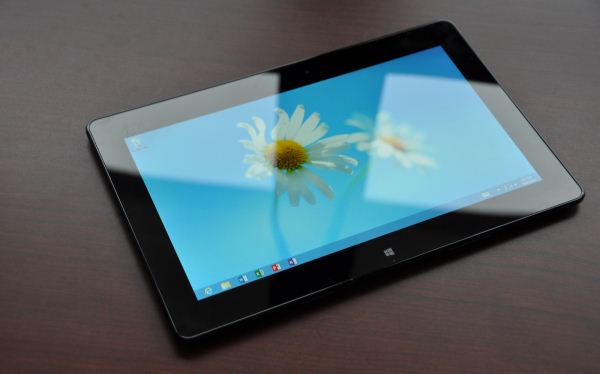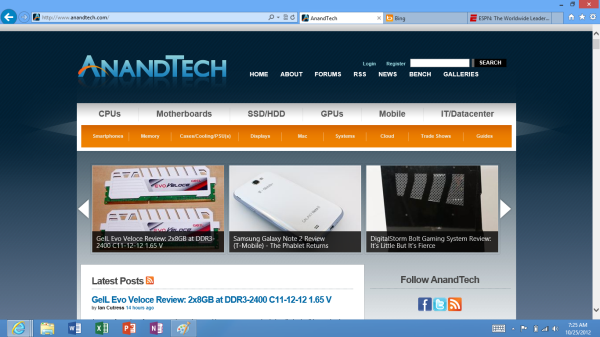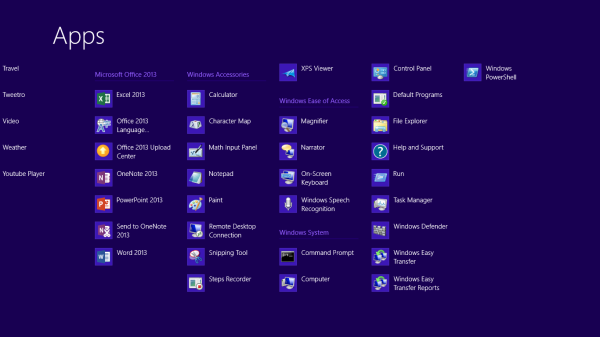The Windows RT Review
by Vivek Gowri & Anand Lal Shimpi on October 25, 2012 12:00 PM EST- Posted in
- Windows RT
- Operating Systems
- Microsoft
- Mobile
- Windows 8
- Tablets
Bridging the Gap, the Dichotomy of Windows RT
by Anand Shimpi
I described Windows RT as being a tablet OS with all of the underlying Windows-ness of Windows. You can get the big full screen app experience in tablet mode, but poke around your file system with Explorer or use Office 2013 like you would on a traditional notebook if you want to. If the two sides of Windows RT remained fairly separate that’d be one thing, unfortunately there are some dependencies between the two sides of the OS that keep the overall user experience from being as friendly as it is in iOS. There are still occasional reminders that you’re dealing with something that’s distinctly Windows here.
Most mobile OSes have done their best to hide the underlying file system and shell from the end user. Microsoft did, in my opinion, the smart thing and avoided hiding its roots with Windows RT. Although the new Start Screen is the default UI for Windows RT, there’s a big desktop tile front and center that will take you back to something far more familiar:
Unlike the Windows 8 desktop, you’re pretty limited in what you can do here. The only applications that are allowed to run in desktop mode under Windows RT are Explorer, IE10, Office 2013 and the command prompt (there are also all of the Windows specific tools and settings which I’ll get to shortly). Developers cannot make applications for Windows RT desktop mode and you can’t sideload anything here. Microsoft’s belief is that by completely locking down the system, requiring that applications only come from the Windows Store, it can avoid the pitfalls of viruses and malware that can plague Windows machines today.
Steve Sinofsky famously quoted an analyst when they asked if Windows RT would be backwards compatible with all of the legacy Windows viruses and spyware. The answer was an astounding no, and this is exactly why we can’t have open season on Windows RT desktop development. There’s also the obvious financial angle to all of this. Microsoft takes a cut of any apps sold through the Windows Store.
Coming from the perspective of a traditional Windows user, the lack of flexibility on the desktop seems wrong. From the perspective of the rest of the ARM based tablet space, it’s not a big deal. At least Windows RT gives you direct, first party access to the file system. There’s very little exposed through iOS, and with Android you need to download a third party app to get access to the file system.
Explorer works just as it would on a Windows 8 PC. The folder structure is exactly as you would expect it on any Windows machine. There are even some x86 remnants in the Windows RT install such as a C:\Windows\SysWOW64 directory complete with x86 binaries inside that obviously won’t run on your Windows RT tablet.
Internet Explorer in desktop mode works just like a traditional IE windows application would work. The desktop app actually controls settings and features for the Metro...err...fancy IE10. For example, if you want to change security settings, clear your history or empty your cache, you have to do all of these things from the IE10 desktop application. Fancy IE10 doesn’t expose them.
The command prompt is, well, a command prompt. It features all of the same commands that you could run before, although once again you can’t simply drop an x86 exe on your system and run it. Not having binary compatibility can be frustrating at times.
Although developers can’t build applications for Windows RT’s desktop, you can write and execute batch files. Keep in mind that if your batch file needs any additional support files (e.g. sleep.exe) you’ll need ARM versions of them which, unless they come from Microsoft, just isn’t happening.
As I mentioned earlier, there are a few other things you can run and do in RT’s desktop mode. Control Panel, event viewer, disk management and all of the other administrative tools that you’d expect to come with Windows are present in Windows RT (including regedit). There are also the little apps that Microsoft has always included, which also work in desktop mode (e.g. mspaint, calc, notepad, etc...)
Ultimately Windows RT is an ARM version of Windows with tablet makeup on. You still get all of the normal bits and pieces of Windows, minus some flexibility and of course, backwards compatibility.
For years we’ve been asking Microsoft to make a clean break with its legacy code and introduce a version of Windows that was built from scratch, with only support for the latest hardware. With Windows RT, Microsoft finally delivered some of that, but in a sort of weird, backwards way.
As Windows RT only supports the ARMv7 instruction set architecture, none of your old x86 applications will run on the platform. Microsoft hoped to avoid this being a problem by shipping an ARM version of Office 2013 Home & Student Edition with Windows RT tablets, and by directing users at the Windows Store for the rest of their application needs. Although it would’ve been possible for Microsoft to enable x86 compatibility through emulation or binary translation, performance would’ve likely been pretty bad.
The loss of backwards compatibility with years of Windows applications feels wrong, but from Microsoft's perspective you don't get that with iOS and Android so there's no real competitive disadvantage here. Why bother with an ARM based version of Windows to begin with? To bring competition to Intel and ensure that it will be able to deliver Windows to the new wave of ultra mobile devices (e.g. tablets). Intel hasn't been competitive on power or pricing at the low end (read: Atom) of the spectrum for years now. The introduction of Windows RT changed that. Atom Z2760 (Clovertrail) is around half the price of the cheapest Atom CPU of the past five years, and it's price competitive with solutions from Qualcomm. We have Windows RT to thank for that. Without pressure from ARM, Clovertrail would've started around $50 per chip just like Intel's low end parts had in the past. As AMD is no longer a pricing check for Intel in some of these new markets, Microsoft had to look for a new way to offer balance. Supporting ARM is its way of doing that. Until there's a new pricing/power/performance x86 competitor to Intel in tablets, ARM and Windows RT will remain.














233 Comments
View All Comments
The0ne - Friday, October 26, 2012 - link
The same search may not present you with the same results however due to changes in Windows 8 but essentially it should be the same.For those complaining this is what you need to make Windows 8 more like Windows 7, completely! Try, love it and move on.
http://classicshell.sourceforge.net/
mga318 - Thursday, October 25, 2012 - link
Really? Are you serious?You have no idea about the specialized software needs of other fields of study...
VivekGowri - Thursday, October 25, 2012 - link
Sorry, sweeping generalization, but I can't think of a class I took in the first two or three years of undergrad that an RT system wouldn't have been adequate for. Only after you start getting into the upper division classes do you start having a lot of non-Office computing needs.SetiroN - Thursday, October 25, 2012 - link
the general public using facebook only are going to keep buying iPads, not windows tablets with physical keyboards.ARM's power consumption advantage is very marginal: the medfield based RAZR i has shown better standby than the almost identical RAZR M, as well as amazing talktime and slightly better video reproduction power consumption; where it fares worse is normal screen-on usage, but overall, it's hardly worse.
So although there still aren't tests available of the newer dual core, I see no reason to expect worse standby power consumption (considering how intel manages to turn cores off completely); also cloverfield supports connected standby, which both ARM and RT do not, and it seems to be a pretty big deal to me.
Clovertrail will run standard windows 8 (call it home premium if you will) which is as full as it gets unless you consider the pro features essential: it will still be able to run windows 8 pro anyway so it's up to OEMs to offer that version preloaded.
As far as I know, the only difference between clovertrail tablets and standard PCs is that the software will be preloaded and the bootloader locked (there is no SATA support anyway); so with the exclusion of other OSs, you will be able to run all the x86 software you want.
So, to the original question: why in the world would I prefer an ARM solution?
SetiroN - Thursday, October 25, 2012 - link
And I don't believe we have to thank RT for Clovertrail: it was clear that Intel would have entered the mobile market, in competition with ARM, anyway.SetiroN - Thursday, October 25, 2012 - link
By "in competition with ARM" I mean It couldn't have done it at higher prices.VivekGowri - Thursday, October 25, 2012 - link
The only thing with Clovertrail is that it comes out to around $200-250 more if you want Office and a keyboard attachment. See $599 VivoTab RT/Surface RT versus the Samsung Series 5 Slate (or whatever they're calling it in the US - ATIV something or other.)It's an 11.6" Clovertrail tablet that goes for $749 with the dock. Looks great, too. But the thing is, you toss in Office 13 on top of that (because it's Windows 8, that's not included) and then the price ends up going from iPad range (RT) to ultrabook range (Clovertrail.)
wsw1982 - Thursday, October 25, 2012 - link
The clovertrail basically has the same price as the windows RT. the Acer W510 and Asus Vivo smart all cost 499. The surface RT is also 499 without the keyboard. But what i really don't understand is why those low end netbook level tablet are all much more expensive then the netbook, it make no sense to me. The article said the clovertrail and tegra 3 are actually half of the price of conventional ATOM which are used in all those cheaper netbooks. The netbook has more expensive processors (40 to 20), mother board (less integration), harddisk (320G harddisk is more expensive than the 32G SSD) and some other staffs (keyboard, big battery, touch pad). The only thing more expensive on the tablet is the display, but I don't think the display could cost 200 more then the display on the netbook.hokiesfan - Thursday, October 25, 2012 - link
I've wondered about that as well. For a very marginal bit of extra weight and thickness and a bit less battery life, you can get a CT based tablet. That should have an enormous advantage in horsepower. I just wish there were some reviews of the CT devices. Hopefully soon. The only advantage I see with RT is the included Office.ssiu - Thursday, October 25, 2012 - link
Ditto here about eagerly waiting for Clover Trail Windows 8 tablet reviews. At least anandtech drops some concrete "Clover Trail is faster than Tegra 3 tablets" benchmark results -- hopefully a full review is imminent.